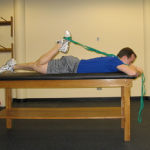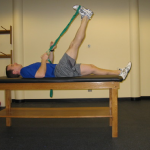
The Bump on Your Shin: What It Is and What to Do
Leave a CommentAs an athletic trainer that works with young, active populations, I get a lot of questions about injuries– some more common than others. One of the more common questions I get– especially adolescents – is “What is this bump below my knee?” The answer is almost always Osgood-Schlatter disease – a condition that sounds like the end of the world, but isn’t anything to lose sleep over.
Osgood-Schlatter disease is the medical term given to the bump that forms on the tibial tuberosity – the spot at the top of your shin where the tendon of the kneecap attaches to the shin bone (tibia). It manifests during adolescent years when our bodies are growing at an exceptional rate. With most of us growing 2-3 inches per year or more, our bones are constantly remodeling – which they do at a pretty fast pace. Unfortunately, muscles tend to lengthen at a slower pace, making them tighter, setting the stage for excess stress to be put on the tibial tuberosity. This stress causes the body to lay down extra bone and the result is a bump that is easily irritated.
Some things that tend to predispose people to getting Osgood-Schlatter disease are unavoidable, such as your rate of growth or whether you’re a male or female (3+ times more common in men than women). The good news, however, is that there are some things you can do to avoid or reduce the severity of this condition. As with any painful condition, it’s best to consult with your physician or athletic trainer as a first step.
Stretch
Since tight muscles cause more tension on the site of the Osgood-Schlatter bump, it’s a good idea to loosen up all of the muscles in the leg – 2 groups in particular. The stretches below will help loosen your quads, which are directly attached to the bump and your hamstrings which, when tight, contribute to extra tension when running and jumping.
Quad Stretch – While laying on your stomach, place a strap (a looped belt or towel works well) around your foot. Pull your heel towards your rear until a stretch is felt across the front of the thigh. Hold this for 30 seconds and repeat 3-5 times.
Hamstring Stretch – Lay on your back and place a strap (again, a belt or towel works well) around your foot. While keeping both legs straight, pull one leg up towards your body until a gentle stretch is felt in the back of your leg. Hold this for 30 seconds and repeat 3-5 times.
Ice
Reducing inflammation is key to controlling pain. Icing the area for 20 minutes after a tough workout is an easy and straightforward way to reduce post-activity pain.
Alter Activities
If sprinting and jumping at high intensities are irritating your knee, it may be time to temporarily scale back your activity level. It sounds like common sense, but “if it hurts, don’t do it” is a phrase that some recovering athletes need to be reminded of again…and again…and again. Replacing running with biking or doing some cross training temporarily can allow the body to catch up with the demands placed on it.
Patellar Tendon Strap
A patellar tendon strap that goes around your knee just below your kneecap can take some of the pressure off of your tibial tuberosity, making activities more tolerable. Keep in mind this strap should ideally serve as a temporary solution until the stretches listed above begin to have an effect. These straps are easily found at sporting goods stores and many bigger pharmacies.
Luckily, most athletes bounce back to full activity in 1-2 weeks and do so relatively comfortably if they are consistent with the preventative ideas listed above. Don’t let Osgood-Schlatter lead to a bumpy* athletic career; be proactive!
*I apologize to all of the readers for the lame pun, but I couldn’t resist.


